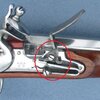There are several companies that offer the 1728 French musket.
According to information that I gleaned from The Rifle Shoppe, the 1728 Infantry Musket had improvements in the three barrel bands. The lock also had a
pan bridle instead of the earlier vertical bridle on the pan. Until the end of the F&I the musket (with later minor changes and called the 1746) was manufactured at at St. Etienne, Maubeuge and Charleville.
This is what is meant by a "pan bridle" and I highly recommend that you get a lock with this type of pan
View attachment 912051
View attachment 912052
these are of course, made from parts fabricated in India. There are those who will claim these are made to be only be used as "wall hangers", which is absurd as I have four 3 British repro muskets and a British repro trade gun from Indian fabricated parts, and ALL function quite well...having been sold with a pre-drilled touch hole and with the idea they would be fired.
. GET the bayonet as well. Even if you have zero idea of ever mounting it or using the musket for reenacting..., if you decide to sell it having a fitting bayonet will very much speed up your resale.
Some will tell you that the guns made from India fabricated parts are fine for blanks but not for live fire....
View attachment 912054 View attachment 912053
Well two different hunts and the squirrels apparently didn't understand that India made tradeguns can't shoot live rounds and they had nothing to worry about.
OH and when shooting shot..., the weight of the shot, and the friction, is more than the weight of a musket ball, and the lock on the trade gun is a tad cruder than those on my other three muskets. It's a 20 gauge so not so rough on the game as would be if I'd used the muskets.
LD





